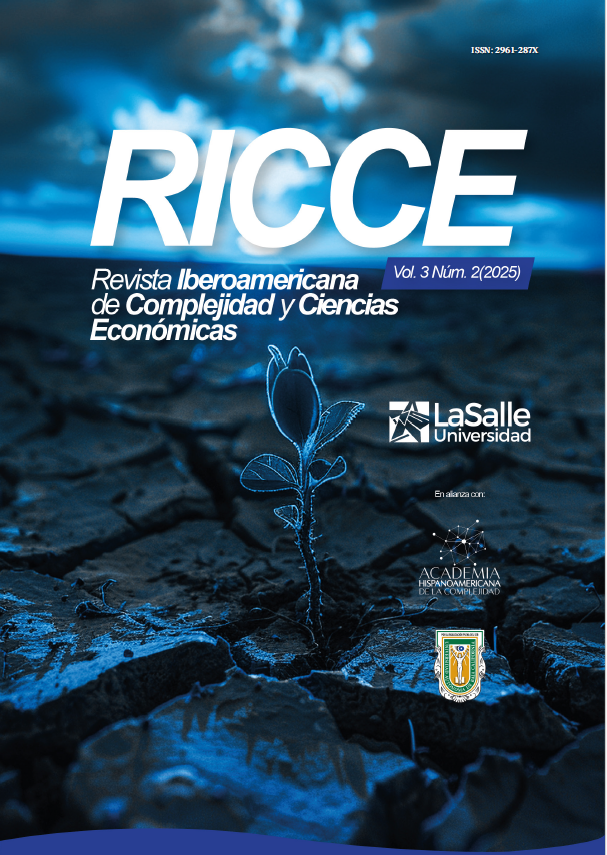ENTROPÍA CURRICULAR Y REDES COMPLEJAS PARA EL DESARROLLO DE PROYECTOS AMBIENTALES ESCOLARES (PRAE)
Resumen
En este artículo se presenta un indicador de entropía curricular y el enfoque de redes complejas de la crisis climática para fortalecer el desarrollo y la contextualización de los Proyectos Ambientales Escolares (PRAE). Esta investigación considera dimensiones socioambientales de la crisis climática, destacando la necesidad de su comprensión holística. En este sentido, teniendo en cuenta los factores ambientales relacionados con este fenómeno como los gases de efecto invernadero (GEI), las quemas y las deforestaciones, se propone la implementación de la noción de entropía curricular como estrategia didáctica que interconecta de manera no lineal del currículo, la participación activa de los estudiantes y fortaleciendo la educación ambiental. Por otro lado, se presenta una metodología de evaluación de entropía de un diseño curricular de una intervención pedagógica, proporcionando una métrica de la diversidad y complejidad de la adaptación curricular. En conclusión, la implementación de indicadores de entropía curricular y la implementación de redes complejas del cambio climático en los Proyectos Ambientales Escolares (PRAE) promueve la comprensión de la flexibilidad, no linealidad en el currículo, y procesos de interdisciplinariedad asociados a redes de mundo pequeño.
Descargas
Citas
Barabasi, A.-L. (2003). Linked: How Everything Is Connected to Everything Else and What It Means for Business, Science, and Everyday Life.
Bastian, M. (2009). (PDF) Gephi: An Open Source Software for Exploring and Manipu¬lating Networks. https://www.researchga¬te.net/publication/221297890_Gephi_An_ Open_Source_Software_for_Exploring_and_ Manipulating_Networks
Bateson, G. (with Internet Archive). (1979). Mind and nature: A necessary unity. New York : Dutton. http://archive.org/details/ mindnaturenecess0000bate
Bryk, A. S., & Schneider, B. (2002). Trust in Schools: A Core Resource for Improvement. Russell Sage Foundation. https://www.js¬tor.org/stable/10.7758/9781610440967
Candia, C., Pulgar, J., & Pinheiro, F. (2022). Interconnectedness in Education Systems.
Castro Sáez, B. (2001). LA ORGANIZACION EDUCATIVA: UNA APROXIMACION DESDE LA COMPLEJIDAD. Estudios pedagógicos (Val¬divia), 27, 97-110. https://doi.org/10.4067/ S0718-07052001000100007
Chevalard, Y. (2013). Chevalard, Y. La Tras¬posición Didáctica. http://archive.org/de-tails/chevalard-y.-la-trasposicion-didactica
Dawson, J. L. (2021). A Guide to Feedback Theory. Cambridge University Press. https:// doi.org/10.1017/9781139018289
Edgar Morin. (2006). Morin, Edgar. El Mé¬todo. Vol. 1. La Naturaleza De La Naturaleza [ocr] [2006]. http://archive.org/details/mo¬rin-edgar.-el-metodo.-vol.-1.-la-naturale¬za-de-la-naturaleza-ocr-2006
Fritzsch, H. (2018). Quarks. En H. Fritzsch (Ed.), Murray Gell-Mann and the Physics of Quarks (pp. 49-51). Springer International Publishing. https://doi.org/10.1007/978-3- 319-92195-2_5
Fullan M. (2007). El nuevo significado del cambio educativo -. https://michaelfullan. ca/books/new-meaning-educational-chan¬ge/
Gell-Mann, M. (1994). Complex Adaptive Sys¬tems (G. Cowan, D. Pines, & D. Meltzer, Eds.; 19; Número 19, pp. 17-45). Addison-Wesley. https://resolver.caltech.edu/CaltechAU-THORS:20150924-144445402
Hattie, J. (2009). Visible Learning: A Syn¬thesis of Over 800 Meta-Analyses Rela¬ting to Achievement. En Visible Learning: A Synthesis of Over 800 Meta-Analyses Relating to Achievement. https://doi. org/10.4324/9780203887332
Herrington J., Oliver Ron. (2000). An ins¬tructional design framework for authentic learning environments | Educational techno¬logy research and development. https://link. springer.com/article/10.1007/BF02319856
Holland, J. H. (2005). El Orden Oculto. Fondo de Cultura Economica USA.
Holling, C. S. (1973). Resilience and Stability of Ecological Systems. Annual Review of Eco¬logy, Evolution, and Systematics, 4(Volume 4, 1973), 1-23. https://doi.org/10.1146/annu¬
rev.es.04.110173.000245
Korthagen Fred A.J. (2009). Situated lear¬ning theory and the pedagogy of teacher education: Towards an integrative view of teacher behavior and teacher learning. CE¬TAR, VU University, Amsterdam, The Nether¬lands. chrome-extension://efaidnbmnnnibp-cajpcglclefindmkaj/https://korthagen.nl/en/ wp-content/uploads/2018/07/Situated-lear¬ning-theory-and-the-pedagogy-of-tea¬cher-education.pdf
Krajcik j. y Blumenfeld P. (2005). Project-Ba¬sed Learning (Chapter 19)—The Cambridge Handbook of the Learning Sciences. https:// www.cambridge.org/core/books/abs/cam-bridge-handbook-of-the-learning-sciences/ projectbased-learning/355AA45D92D7FCD-5D312FD1C343FDBB2
Leff, E. (2000). Saber ambiental: Sustentabili¬dad, racionalidad, complejidad, poder / E. Leff.
Leinster, T. (2020). Entropy and diversity The axiomatic approach.
Maldonado, C. E. (2016). Pensar como la na¬turaleza. Una idea radical. Uni-pluriversidad, 16(2), 41-51.
Maturana, H. R. (with Internet Archive). (1980). Autopoiesis and cognition: The reali¬zation of the living. Dordrecht, Holland ; Bos¬ton : D. Reidel Pub. Co. http://archive.org/de-tails/autopoiesiscogni0042matu
Minambiente. (2019). Guía PRAE. https:// www.minambiente.gov.co/documento-enti-dad/guia-prae/
Newman, M. E. J. (2003). The structure and function of complex networks. SIAM Review, 45(2), 167-256. https://doi.org/10.1137/ S003614450342480
Penrose Roger , Jorgensen Palle. (2008). The Road to Reality: A Complete Guide to the Laws of the Universe. https://www.resear¬chgate.net/publication/226597688_The_ Road_to_Reality_A_Complete_Guide_to_ the_Laws_of_the_Universe
Perkins, D. (2009). Making learning who¬le: How seven principles of teaching can transform education: Perkins, David N : Free Download, Borrow, and Streaming: Internet Archive. https://archive.org/details/makin¬glearningwh0000perk
Perkins, D. (2023). Perkins, D. Educar Para Un Mundo Cambiante ¿ Qué Necesitan Apren¬der Realmente Los Alumnos Para El Futuro. http://archive.org/details/perkins-d.-edu-car-para-un-mundo-cambiante-que-nece¬sitan-aprender-realmente-los-a
Prigogine, I. (1997). Prigogine, Ilya. Las Le¬yes Del Caos [ocr] [1997]. http://archive.org/ details/prigogine-ilya.-las-leyes-del-caos-ocr-1997
Prigogine, I., & Rysselberghe, P. V. (1963). Introduction to Thermodynamics of Irre¬versible Processes. Journal of The Electro¬chemical Society, 110(4), 97C. https://doi. org/10.1149/1.2425756
Shannon, C. E. (1948). A Mathematical Theory of Communication.
Stiggins, R. (2005). From Formative Assess¬ment to Assessment for Learning: A Path to Success in Standards-Based Schools. Phi Delta Kappan, 87(4), 324-328. https://doi. org/10.1177/003172170508700414
Derechos de autor 2025 Revista Iberoamericana de Complejidad y Ciencias Económicas

Esta obra está bajo licencia internacional Creative Commons Reconocimiento-NoComercial-SinObrasDerivadas 4.0.
Los autores ceden exclusivamente el derecho de publicación de su artículo a la Revista Iberoamericana de Complejidad y Ciencias Económicas, que podrá editar o modificar formalmente el texto aprobado para cumplir con las normas editoriales propias y con los estándares gramaticales universales, antes de su publicación; asimismo, nuestra revista podrá traducir los manuscritos aprobados a cuantos idiomas considere necesario y difundirlos en varios países, dándole siempre el reconocimiento público al autor o autores de la investigación.









